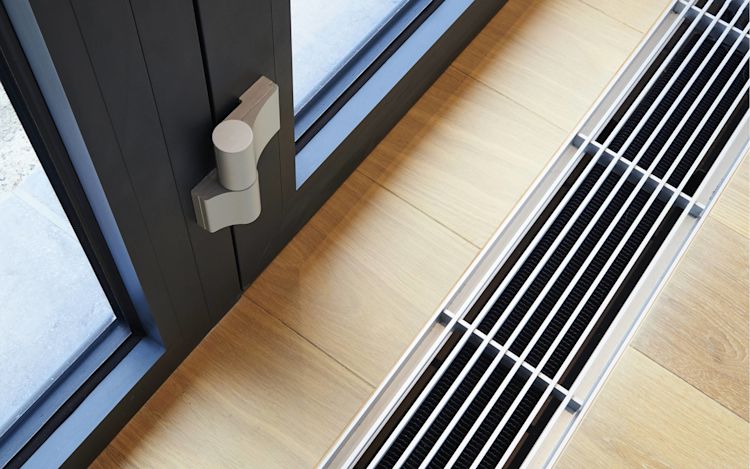This Is Why a Heat Pump Could Be in Your Home’s Future
We spoke with heat pump installer Trish Young to find out how heat pumps win on cost, comfort, and climate.
by ecobee on 08/28/2023 in Smart Home & Tech
9 min read

By switching to a heat pump, you should know that you are taking a giant leap in reducing your household carbon footprint.
A heat pump can reduce your home’s greenhouse emissions by up to eight tonnes per year, which is equivalent to taking a mid-sized car off the road. That’s why experts say buying a heat pump is one of the biggest things a consumer can do to fight climate change.
Heat pumps are not only good for the planet because they are incredibly energy efficient, but they can also cost less to operate. They cost about the same to operate as your current furnace but cost less to operate than your current air conditioner.
A heat pump is essentially a fancy “air conditioner” with a reversing value so that it can move heat in both directions using electricity. Unlike furnaces that burn oil or gas to generate heat, during winter, the most common type of heat pump, called an air-source heat pump, works by absorbing heat from outdoor air and moving it to the indoors via a refrigerant loop. It works in reverse during the summer. There are other types of heat pumps, including ground-source (i.e., geothermal) and water-source, but in this article, we’ll focus on air-source heat pumps because they are more affordable, qualify for rebates, and easy to install.
Air-source heat pumps fall into two categories. The first type is the traditional “staged” heat pump, which allows for one or two levels of operation or heating and cooling speeds. These are predominant in the southern U.S., where they are a good fit for hot summers and mild winters. Recent technological advancements have brought us a new type called the modern variable speed heat pump. It uses an inverter to fine-tune its output for higher efficiency and better performance, even in places with cold winters.
A heat pump can reduce your home’s greenhouse emissions by up to eight tonnes per year, which is equivalent to taking a mid-sized car off the road.
To help us learn more about air-source heat pumps, including how modern variable speed heat pumps, sometimes called inverter or variable capacity heat pumps, work with ecobee thermostats, we spoke to Trish Long, founder and owner of Switch Heat Pumps, a Toronto-based heat pump installer.
Here are some of Long’s top pointers and insights for ecobee Smart Owners considering a heat pump. For even more about heat pumps, check out our full post on Everything You've Ever Wanted to Know About Heat Pumps.

Can I install one in my home?
Heat pumps can be adapted to most home layouts and can be used in homes that have ductwork and homes that do not. If you have existing ductwork in your home, you can use it to move air from a “centrally-ducted" heat pump. But ducts are not required. Air-source heat pumps are also available in what are called “ductless mini-splits.” They can also be set up as a hybrid system with both ducted and ductless indoor units feeding off one outdoor compressor.

Will it work with my ecobee smart thermostat?
ecobee smart thermostats have always worked with traditional staged heat pumps. But smart thermostats, including ecobee smart thermostats, need an adapter to work with modern variable speed heat pumps with inverter technology. These are available from HVAC manufacturers and third parties. Installation is technical, so we recommend finding an experienced professional to do the job. The perfect time to install the interface is when your technician installs the heat pump. Once the interface is installed, you can enjoy the essential benefits of a modern heat pump—including variable fan speeds—with everything you love from your ecobee.
What it’s like to live with a modern variable speed heat pump?
The crucial thing is getting the right size heat pump for your home. Bigger is not better. With the correct size heat pump, you will experience a quieter system that will run for longer periods at lower speeds than a traditional furnace or air conditioner for more consistent heating and cooling.
Because modern variable speed heat pumps run almost continuously, they are also better than air conditioners at dehumidification, making the air feel naturally cooler and reducing cooling costs. And because the air they generate is naturally cooler than air produced by combustion, a heat pump won’t dry out your home in the winter the same way a furnace does.

How do I get the right size heat pump for my home?
This will depend on a range of factors particular to your home, including the size and layout of your property, insulation, and electrical requirements. Many people are tempted to buy an oversized heat pump for their home. Buying a heat pump that is bigger than you need will, perhaps counterintuitively, result in shorter heating and cooling cycles, higher bills, and a less comfortable home. An oversized system may also disqualify you from rebates.
Instead, make sure your installer “right sizes” the heat pump. This means getting the heat pump that will run the most efficiently, and if you live in a northern climate, installing an electric resistance backup heater or using your old furnace to pick up the slack on the chilliest days of the year (colder than −22°F (−30°C)).
I’ve heard heat pumps are more expensive to operate than natural gas or oil-based heating systems. Is that true?
Not true. Modern heat pumps are three times more efficient in cold climates than gas or oil-based heating systems and electric radiators. This means that they make three or four units of heat for every unit of electricity they consume. Because of their great efficiency, heating your home with a heat pump will cost you about the same or less than your current spending on fuel, even though electricity is generally more expensive than natural gas.
In addition, if the heat pump is replacing an air conditioner, you will save hundreds of dollars annually on cooling because heat pumps generally have a much higher Seasonal Energy Efficiency Rating (SEER) rating than the air conditioner they are replacing.

Can heat pumps work efficiently in cold climates?
Yes. For example, in Norway which has cold harsh winters, more than 60% of homes use heat pumps.
Modern heat pumps work at variable speeds to maximize energy efficiency and match your home’s heating demand with precision. With variable speeds, the heat pump can operate more efficiently at colder temperatures by running slowly and speeding up as needed to bring more heat into the home.
If you live in an area where the temperature consistently drops below 32°F (or 0°C) during the winter, you will need to install a cold-climate heat pump that is rated to work efficiently down to −22°F (−30°C). For peace of mind, Long recommends asking your technician to install a backup electric resistance heater to support your heat pump on the very coldest days. You can also use your old furnace in a backup role.
“Last winter there were only three days where the backup was needed in my home. It doesn’t come on very much, so it doesn’t add up to a lot of money,” said Long.
If you live in a region where temperatures stay below −22°F (−30°C) for long periods, a backup furnace may be recommended.
I want to buy a heat pump. Where do I start?
If you’re thinking about upgrading your heating and cooling system, start with an energy audit. The auditor will advise you on how you can improve your home’s energy efficiency and qualify you for eligible rebates and incentives. The U.S. Department of Energy recommends checking with your state or local government’s energy or weatherization office to help you identify a qualified company to perform the audit.

How do I choose an installer?
Go with an experienced installer. Most installers will be familiar with installing mini-splits. If you have existing ductwork and are replacing your furnace and air conditioner, Long recommends asking prospective installers if they’ve had experience installing a centrally-ducted heat pump and requesting references.
“People with heat pumps love them, and they’re usually delighted to tell others about their experience,” said Long.
Look for a one-to-two-year warranty on labor and expect a 10-year manufacturer’s warranty on the equipment.

Are there rebates and tax incentives to offset the higher upfront costs?
Yes, in most places there are. You can expect to pay $10,000–$16,500 USD ($13,300–$22,000 CAD) upfront to buy and install a heat pump in your home. However, many states and provinces have rebates or tax incentives to offset the higher upfront costs. Consumers in the U.S. can expect to deduct the cost of the heat pump at tax time while Canadians will typically receive a rebate after purchase. According to the International Energy Agency, these subsidies make the cheapest heat pump options similar in price to gas furnaces. If you are buying a more expensive model, you can expect to make up the difference over the unit’s lifetime with household savings of $300 USD per year compared to gas.*
What else should I know?
We learned so much about heat pumps from Trish, more than we could fit here. That’s why we invite you to read the full interview, where we go in-depth on everything from comparing noise levels (heat pumps are very quiet) to what the emergence of heat pumps means for the fight against climate change (game changer).

About Trish Long
Trish Long and her business partner Sara Grant co-founded Goldfinch Energy in 2020 after Long, who was then working in climate policy, had a furnace breakdown and sought a greener alternative to gas. “I was laughed out of the room,” she recalls. Goldfinch Energy became a one-stop shop for clients looking to identify heat loss in their homes and provide energy solutions.
Replacing a gas furnace or boiler with a heat pump is a surefire way to improve a home’s efficiency and cut carbon emissions. That is why Trish and business partner Mike Holm, a talented heat pump technician, started Switch Heat Pumps in 2022. Trish and Mike are putting their collective 30 years’ experience in heat pumps, climate policy and available rebates to good use, helping Torontonians open the door to carbon-free heating and cooling.
Trish's career includes roles at Evergreen Brick Works, the Pembina Institute, Trees for Life, and volunteer work at Shift: Action for Pension Wealth and Planet Health.
*International Energy Agency, “Executive Summary – The Future of Heat Pumps”
Did you enjoy this article?
Thanks for letting us know!






